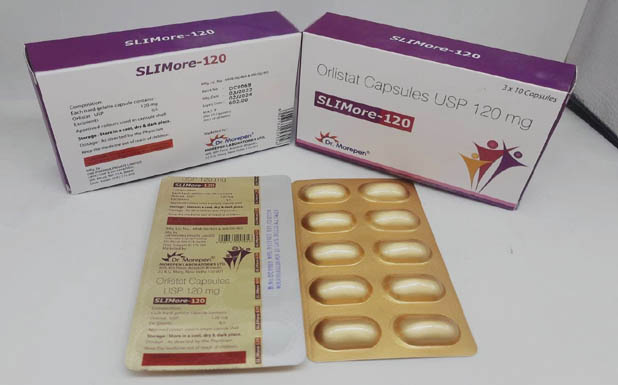Indications and Usage
● Orlistat 120 mg ( Anti Obesity ) Capsule is used for the treatment of obesity.
● It also leads to a modest reduction in blood pressure.
● Reduce the risk of high cholesterol levels.
● Use in weight loss.
Mechanism of Action
Orlistat works by inhibiting gastric and pancreatic lipases, the enzymes that break down triglycerides in the intestine. When lipase activity is blocked, triglycerides from the diet are not hydrolyzed into absorbable free fatty acids, and are excreted undigested instead. Only trace amounts of orlistat are absorbed systemically; the primary effect is local lipase inhibition within the GI tract after an oral dose. The primary route of elimination is through the feces. At the standard prescription dose of 120 mg three times daily before meals, orlistat prevents approximately 30% of dietary fat from being absorbed, and about 25% at the standard over-the-counter dose of 60 mg. Higher doses do not produce more potent effects.
Drug Interaction
Its primary function is preventing the absorption of fats from the human diet, thereby reducing caloric intake. It is intended for use in conjunction with a physician-supervised reduced-calorie diet. Orlistat is the saturated derivative of lipstatin, a potent natural inhibitor of pancreatic lipases isolated from the bacterium Streptomyces toxytricini. However, due to simplicity and stability, orlistat rather than lipstatin was developed into an anti-obesity drug.
The effectiveness of orlistat in promoting weight loss is definite, though modest. Pooled data from clinical trials suggest that people given orlistat in addition to lifestyle modifications, such as diet and exercise, lose about 2-3 kilograms (4.4-6.6 lb) more than those not taking the drug over the course of a year. Orlistat also modestly reduces blood pressure, and appears to prevent the onset of type 2 diabetes, whether due to weight loss itself or to other effects; in a large randomized controlled trial, orlistat was found to reduce the incidence of diabetes by nearly 40% in obese people.
The blood thinning effect of warfarin (Coumadin) depends on the amount of vitamin K in the body, and vitamin K is one of the vitamins that binds to fat. Patients receiving warfarin who begin orlistat should have their blood clotting monitored closely because the orlistat may cause levels of vitamin K to decline. This will increase the effects of warfarin and lead to abnormal bleeding from the warfarin. There is no evidence that a deficiency of vitamin K occurs in patients who are taking orlistat.
Orlistat may reduce the absorption and blood levels of cyclosporine (Sandimmune) when both drugs are administered together. Therefore, cyclosporine should be administered two hours before or after orlistat, and more frequent monitoring of cyclosporine levels may be needed.
Contraindication
Contraindicated in patients with reduced gallbladder function, malabsorption, who are taking cyclosporine, underwent an organ transplant and hypersensitivity.
Side Effects
Oily spotting, loose stools, nausea, vomiting, stomach pain and loss of appetite, irregular periods, dark colored urine, hives, rash, itching and difficulty in breathing Headache and anxiety.
Storage
Store it at room temperature and in an airtight container.
Disclaimer:The data uploaded is made from content already available on internet.The company holds no right of it and is not responsible for any wrong information.
